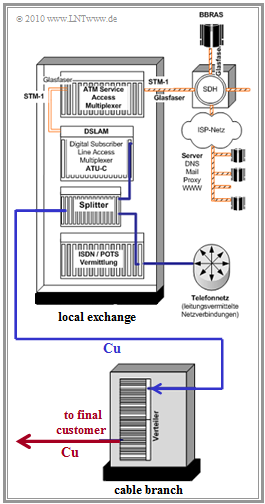$\rm xDSL$ is a very broad generic term that includes a whole range of different system variants for fast Internet access:
- $\rm ADSL$: Asymmetric Digital Subscriber Line,
- the extensions $\rm ADSL2$ and $\rm ADSL2+$,
- $\rm VDSL$: Very high-speed Digital Subscriber Line, in Germany the system $\rm VDSL(2)$.
The exercise includes some general questions about the three system variants mentioned above.
Hints:
- This exercise belongs to the chapter "xDSL Systems".
- The graphic shows the local exchange as well as the cable branch of one of the above mentioned variants.
Questions
Solution
(1) Correct is the proposed solution 1: The graphic shows ADSL.
- In VDSL, the DSLAM (Digital Subscriber Line Access Multiplexer) is located in the cable branch.
(2) Only the proposed solution 2 is correct:
- The fiber termination point is usually in the DSLAM in DSL. Only in the ADSL variant is the DSLAM located in the local exchange.
- In contrast, the DSLAM in the VDSL variant is located in the cable distribution frame (or for the VDSL(2) variant in the Outdoor DSLAM next to the cable distribution frame) in order to reduce the "last mile" (length of the copper line) and thus achieve higher data rates.
- The fiber optic termination is located at the end customer only if FttH or FttB technologies are used.
- However, it is then no longer DSL.
(3) Only the proposed solution 4 is correct:
- The splitter contains one low-pass and one high-pass filter.
- It can thus separate the low frequencies (telephone signal) from the higher frequencies (xDSL signal).
(4) Correct arestatements 1 and 3:
- In fact, ADSL systems always reserve 32 kbit/s for administrative data.
- In contrast, with ADSL2 the length of the overhead can vary between 4 kbit/s and 32 kbit/s. If it is reduced, a higher user data rate is achieved.
- Statement 3 is correct: By including Seamless Rate Adaptation in the standard, a possible loss of synchronization in case of a variation of the channel quality can be avoided.
In contrast, the last statement is incorrect:
- The maximum achievable data rate for VDSL(2) is indeed (theoretically) 250 Mbit/s. However, the data rate drops to as low as 100 Mbit/s at a distance of 500 meters. At 2000 meters of copper line, it is even less than 10 Mbit/s.
- ADSL2+, on the other hand, achieves a maximum of "only" 25 Mbit/s, but the data rate decreases much more slowly than VDSL(2) at greater distances and is still approximately 15 Mbit/s at 2000 meters. The "intersection point" is at about 1500 meters.
